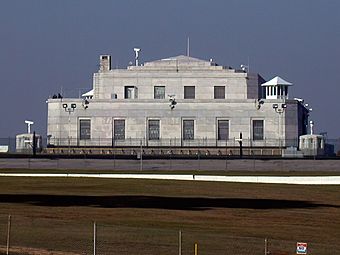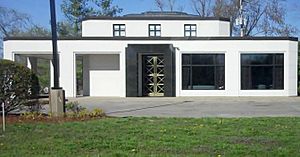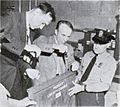United States Bullion Depository facts for kids
Quick facts for kids |
|
|
United States Bullion Depository
Fort Knox, Kentucky |
|

The United States Bullion Depository
|
|
| Location | Gold Vault Rd. and Bullion Blvd. Fort Knox, Kentucky |
|---|---|
| Area | 42 acres (17 ha) |
| Built | 1936 |
| Built by | Great Lakes Construction |
| Architect | Louis A. Simon |
| Engineer | Neal A. Melick |
| Architectural style | Art Deco |
| NRHP reference No. | 88000056 |
| Added to NRHP | February 18, 1988 |
The United States Bullion Depository, often called Fort Knox, is a super strong vault building. It's right next to the United States Army base in Fort Knox, Kentucky. The United States Department of the Treasury runs it.
This vault holds a huge amount of the United States' gold reserves. It also keeps other valuable things safe for the government. Right now, it has about 147 million troy ounces of gold. This is more than half of all the gold the Treasury owns. The United States Mint Police protects this important building.
The Treasury built Fort Knox in 1936. They got the land from the military. The goal was to move gold from cities like New York City and Philadelphia. This made the gold safer from possible attacks. The first gold arrived in 1937. More gold came in 1941. These shipments moved almost two-thirds of all U.S. gold. The United States Post Office Department helped move it.
During World War II, many important documents were stored here. These included the original Constitution of the United States and the United States Declaration of Independence. Even a Gutenberg Bible and a copy of the Magna Carta were kept safe. After the war, the Crown of St. Stephen was stored there. Today, it holds rare gold coins, a special penny, and gold Sacagawea dollar coins that went to space.
Fort Knox is a very secure place. It has fences, razor wire, and even minefields around it. Cameras and microphones watch the area day and night. The underground vault is made of steel and concrete. Its door is 21 inches (53 cm) thick and weighs 20 tons (18 metric tons). The vault door has a special time lock. Only staff members can open it by dialing separate codes. No visitors are allowed inside. Because it's so safe, people say "as safe as Fort Knox" to mean something is very secure.
Contents
Fort Knox: A Safe Place for Gold
In 1933, President Franklin D. Roosevelt made a rule. It said that people could not privately own gold coins or bars. They had to sell them to the Federal Reserve. Because of this, the amount of gold the government had grew a lot. Between 1933 and 1937, it went from $4 billion to $12 billion. The government needed a new place to store all this gold.
So, in 1936, the United States Department of the Treasury started building the Bullion Depository. It was built at Fort Knox, Kentucky, on land from the United States Army. The Gold Vault was finished in December 1936. It cost about $560,000. The building is on Bullion Boulevard at Gold Vault Road. In 1988, it was added to the National Register of Historic Places. This was because it is important to U.S. economic history. It is made of granite from North Carolina.
The first gold arrived from January to July 1937. Most of the U.S. gold reserves were moved there. This included old gold bars and new bars made from melted gold coins. Some whole coins were also stored. The transfer used 500 train cars. It was sent by registered mail and protected by the United States Postal Inspection Service.
In 1974, a lawyer named Peter Beter claimed the gold was gone. He said the vaults were empty. To prove him wrong, reporters were allowed inside. This was the only time the public has ever been allowed in.
During World War II, Fort Knox held very important items. It kept the original United States Declaration of Independence and Constitution of the United States safe. It also held treasures from other countries. For example, the Crown of St. Stephen from Hungary was stored there. This was to keep it from falling into Soviet hands. A copy of the Magna Carta was also kept there during the war. It had been sent for a fair in New York.
How Fort Knox Is Protected
The main vault is below the building. It has granite walls and a very strong, blast-proof door. This door weighs 20 tons (18 metric tons). Staff members must dial different codes to open it. No one person knows all the codes. Inside the main vault, there are smaller, extra-secure rooms.
A company that made the vault door said:
The most famous vault door order came from the government in 1935 for Fort Knox. Both the main door and emergency door were 21 inches thick. They were made of material that resists torches and drills. The main door weighed 20 tons, and the vault walls were 25 inches thick.
Fences surround the building. The United States Mint Police guard it. Fort Knox is inside a U.S. Army base. This means the Army can provide even more protection. The Depository has many layers of security. These include alarms, cameras, microphones, mine fields, and razor wire. There are also electric fences and heavily armed guards. Army units from Fort Knox can help too. These include Apache helicopters and many soldiers with tanks and other vehicles.
There is even an escape tunnel from the lower part of the vault. This is for anyone who might accidentally get locked inside.
For safety, no visitors are allowed on the grounds. This rule has been in place since the vault opened. The only time it was broken was in 1974. Members of United States Congress and the news media were allowed to inspect it. This visit was led by Mary Brooks, who was the Director of the United States Mint.
What Gold Is Stored There?
As of April 2016, Fort Knox holds 4,582 metric tons of gold. This is about 147.3 million troy ounces. At a price of $1,226.60 an ounce, this gold is worth about $180 billion. The depository also holds gold coins.
Not all the gold bars are exactly the same. Some are almost pure gold. Other bars are made from melted gold coins. These "coin bars" are 90% gold. This was the type of gold used for U.S. coins before 1933. This mix made the coins tougher for everyday use.
The U.S. holds more gold than any other country. It has about 8,133 metric tons in total. This is about 2.4 times more than Germany, which is the next country with the most gold.
Fort Knox in Popular Culture
Fort Knox has become a symbol of a super strong vault. People use phrases like "locked up tighter than Fort Knox" or "safer than Fort Knox." Many businesses nearby even use the name. The huge amount of gold there also led to the phrase "not for all the gold in Fort Knox." This means you would never do something, no matter what.
- In the 1937 film Behind the Headlines, there's a plan to steal gold on its way to Fort Knox.
- The 1951 Abbott and Costello film Comin' Round the Mountain shows them finding gold. But they end up inside Fort Knox and get arrested! The 1951 cartoon 14 Carrot Rabbit with Bugs Bunny has a similar ending.
- The famous 1959 James Bond novel Goldfinger and the 1964 movie are about a plan to break into Fort Knox. In the book, the bad guy wants to steal the gold. In the movie, he plans to make the gold radioactive. This would hurt the economy and make his own gold worth more.
- In the 2000 movie Battlefield Earth, humans trick aliens into thinking they are mining for gold. They do this by breaking into Fort Knox and giving the aliens the gold stored there.
- In the Soviet comedy western A Man from the Boulevard des Capucines, a character says, "The heart of Miss Little is locked tighter than Fort Knox." Later, when she shows kindness, someone says, "Seems Fort Knox has fallen."
- In Star Trek: Voyager, Captain Kathryn Janeway plans to steal a special part from a Borg ship. She calls it "Operation Fort Knox." The episode explains that in the future, Fort Knox becomes a museum.
- An episode of America's Book of Secrets from 2012 was called "Fort Knox." It talked about the history, facts, and rumors about the place.
- Samsung Knox, a security system for phones, is named after Fort Knox.
Images for kids
-
Archibald Macleish unboxing the Declaration of Independence and U.S. Constitution after arriving back to the Library of Congress in October, 1944 after having been stored at Fort Knox.
-
U.S. Bullion Depository. Taken 1968, four years after the movie Goldfinger










